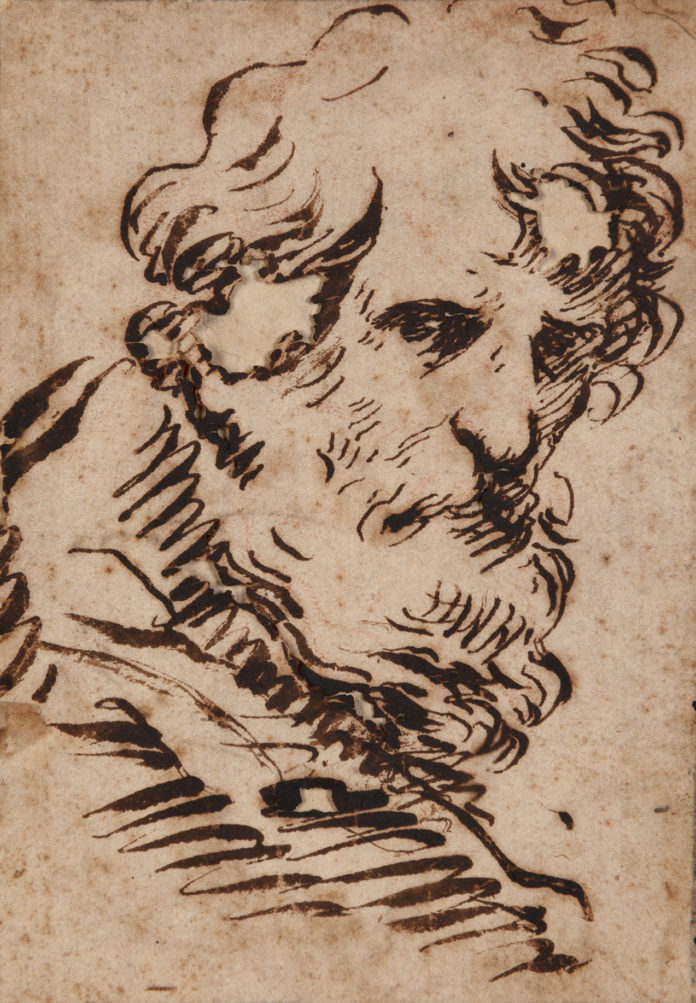
The Meadows Museum, SMU (Dallas, Texas), announced recently that it has acquired six new works for its collection: five Spanish drawings from the seventeenth and eighteenth centuries, including one by Alonso Cano (1601–1667), and one terracotta sculpture by the Catalan Modernist Agustín Querol y Subirats (1864–1909).
From the museum:
Purchased together from De la Mano Gallery in Madrid, Spain, the five sheets reflect the strong tradition of Spanish draftsmanship in the early modern period, and significantly enhance the museum’s collection of drawings.
Works by Francisco de Herrera the Elder (c. 1590–1654) and Pedro Duque Cornejo (1678–1757) are the first by these artists to enter the Meadows’ collection, while other drawings offer new insight into the creative processes of artists already represented, including Alonso Cano, Mariano Salvador Maella (1739–1819), and José Camarón Bonanat (1731–1803).
The sculpture by Agustín Querol y Subirats adds to the Meadows’ growing collection of Catalan art and joins two important paintings, one by Catalan artist Josep de Togores i Llach (1893–1970) and the other by Santiago Rusiñol i Prats (1861–1931), both acquired by the museum earlier this year.
“We are looking forward to the scholarship that will result from studying these newly acquired works alongside those already in our collection,” said Mark Roglán, the Linda P. and William A. Custard Director of the Meadows Museum. “It is important to have a drawing by Alonso Cano, one of the Golden Age’s masters of the Spanish School and a colleague of Velázquez, in addition to the Cano painting already in the collection. The significant addition of the other four sheets to our Spanish drawings collection—including a beautifully rendered head by Francisco de Herrera the Elder—is likely to spur new research and perhaps even result in publications and exhibitions that further deepen our understanding of Spanish draftsmanship and its influence on the built environment and culture of seventeenth and eighteenth-century Spain. Meanwhile, the acquisition of the Querol work is a milestone in the growth of holdings that represent both modernist and Catalan art, areas of the collection that the Meadows is committed to developing further.”
About the Works
“The Death of Mary Magdalene” is the first work on paper by Alonso Cano to enter the Meadows Museum’s collection, joining a small panel painting by the artist titled “Christ Child” (c. 1628–29).
Cano was a master draftsman, painter, architect, sculptor and designer who is best known for his work at Granada Cathedral, where he became clergy in 1652. His oeuvre includes a series of paintings on the life of the Virgin Mary as well as the design for the cathedral’s façade, which was built posthumously.
Cano studied painting alongside Diego Velázquez and under Francisco Pacheco and studied sculpture under Juan Martínez Montañes while in Seville. Scholars have identified only about 120 of the artist’s drawings, most of which are now in Spanish museums, making this acquisition quite rare, especially for a U.S. institution.
Like many of Cano’s drawings, “The Death of Mary Magdalene” is small in scale and created with dynamic marks that are informal in appearance. “The Death of Mary Magdalene” is likely a preparatory sketch for which there is no known finished work. The drawing, which features a female figure recumbent on a mat or bed with two small angels above her, demonstrates the artist’s skillful draftsmanship and mark-making. This sheet is part of a lot of five drawings purchased together from De la Mano Gallery, Madrid, Spain.
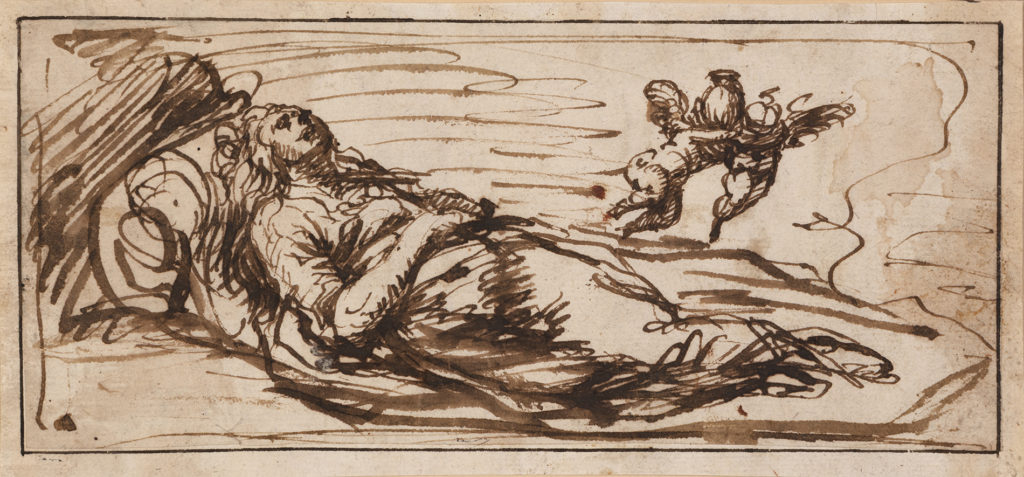
***
Francisco de Herrera the Elder was an esteemed artist who was central to the cultural life of early seventeenth-century Seville. Drawings by the artist appear in the collections of major museums worldwide, including the Metropolitan Museum of Art, New York; the Museo Nacional del Prado, Madrid; and the Hamburger Kunsthalle.
His work serves as a representative example of the shift that many artists made during the period, moving away from the elongated forms of Mannerism toward the more naturalistic tendencies characteristic of the high Baroque. “Bearded Head in Half‐Profile” is a later work by the artist that demonstrates his embrace of naturalism. In this drawing, Herrera the Elder portrayed an older man in half profile, capturing his subject’s facial features with marks that are economical but effective.
Herrera the Elder frequently studied heads, observing and documenting the details of human faces and facial expressions as in this drawing. “Bearded Head in Half‐Profile” is the first work by Herrera the Elder to enter the Meadows collection, and is part of a lot of five drawings purchased together from De la Mano Gallery, Madrid, Spain.
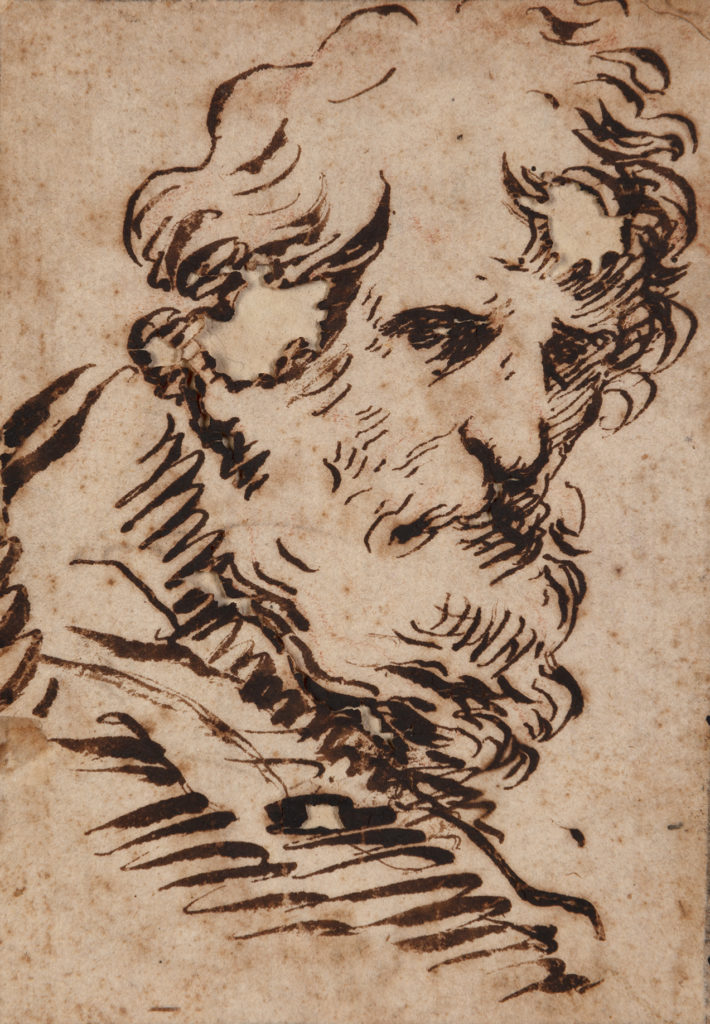
***
Pedro Duque Cornejo was a Baroque artist known for his sculptural and architectural works. A disciple of his grandfather, the sculptor Pedro Roldán, Duque Cornejo was born in Seville and primarily worked in his home city as well as in Granada and Córdoba.
Among others, Duque Cornejo is known for his work as a master architect and sculptor for the altarpiece of the Church of San Lorenzo in Seville, two altarpieces for the Monastery of Santa María de las Cuevas in Seville, sculptures for the Cartuja Monastery of Granada and the Monastery of Santa María de El Paular in Madrid, and the choir of the Cathedral of Córdoba.
Duque Cornejo used drawings, such as this “The Immaculate Conception, Saint Ferdinand, and a Seated Angel,” to aid his sculptural practice. In this work, three unrelated sketches appear on the same sheet along with corresponding notes, suggesting the artist may have used one sheet for planning various projects.
These preliminary sketches have not yet been definitively assigned to final works created by the artist, allowing for the possibility of further research and study of his artistic process.
This sketch, the first example of the artist’s work to enter the Meadows collection, joins a terracotta sculpture by Pedro’s aunt, Luisa Roldán, titled “Infant Saint John the Baptist.” This work is part of a lot of five drawings purchased together from De la Mano Gallery, Madrid, Spain.
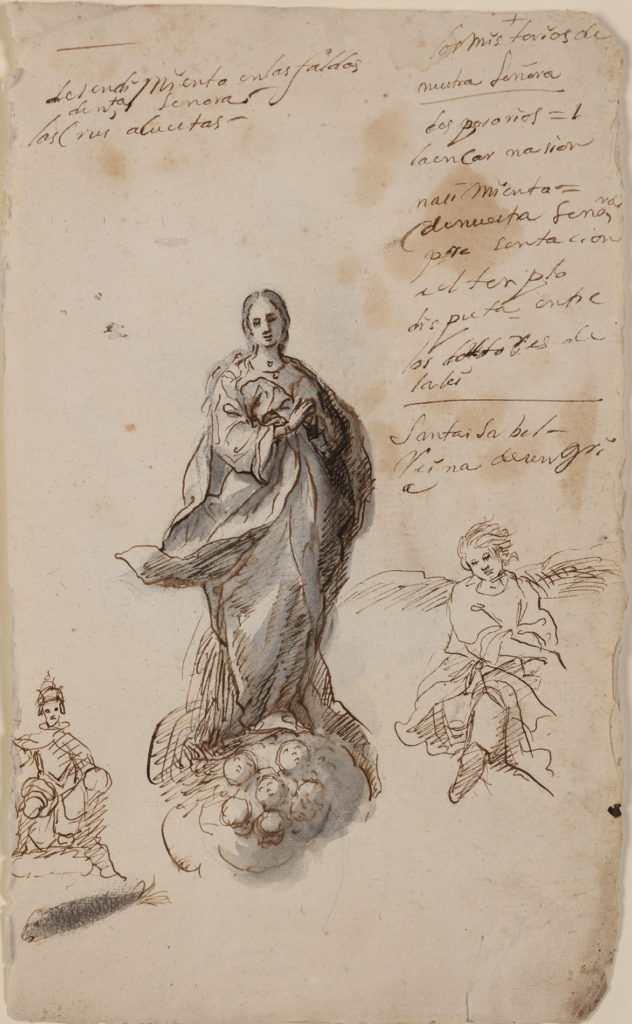
***
José Camarón Bonanat (or Boronat) was a Spanish draftsman, painter, and printmaker who was one of the most esteemed artists in Valencia during the second half of the eighteenth century. Camarón was one of the founding members of the Real Academia de Bellas Artes de San Carlos in Valencia; he served as that academy’s director of painting in 1790 and its general director from 1796 until 1801.
Among others, he is well known for his religious commissions, including those for Valencia Cathedral and San Francisco el Grande in Madrid.
Many of Camarón’s drawings, such as this work, were reproduced by engravers as book illustrations. The front side of this sheet features three highly finished drawings of cartouches.
Reproduced in prints by Hipòlit Ricarte, these cartouches were used to illustrate the texts on a 1761 map of the Archbishopric of Valencia created by cartographer Tomás Vilanova. The sheet is likely a final version of Camarón’s designs as the drawing and the printed map—copies of which are housed at the Universidad Politécnica in Valencia, the Universidad de Lleida, and the Biblioteca Nacional de España in Madrid—are very similar.
The other side of the sheet features small sketches that seem to have been completed more quickly than those on the front, which have not yet been matched with finished works by the artist, thus presenting an opportunity for further study.
This acquisition is the second work by Camarón to enter the Meadows Museum collection; it joins another drawing, “The Madonna and Child in Glory Surrounded by Saints and Putti.” This work is part of a lot of five drawings purchased together from De la Mano Gallery, Madrid, Spain.
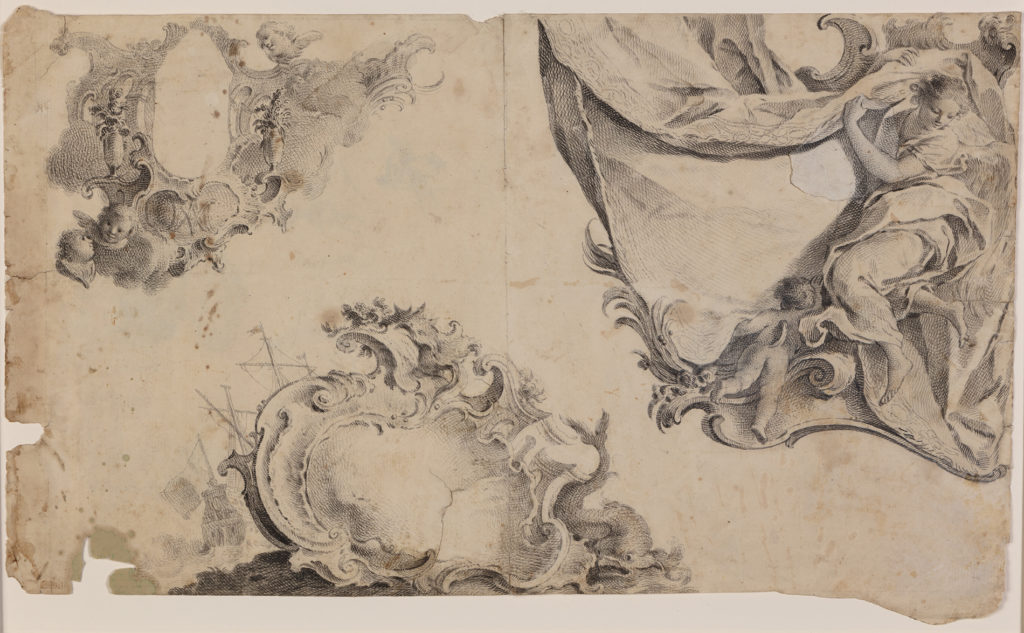
Mariano Salvador Maella was a master of eighteenth-century Spanish art. Maella was employed at the Spanish court of the Bourbon kings Charles III (r. 1759–1788) and Charles IV (r. 1788–1808), and was greatly admired as a draftsman. During his lifetime, his work was acquired by the Real Academia de Bellas Artes de San Fernando in Madrid and used to teach students at the academy.
“Portrait of Christopher Columbus” was commissioned by the historian and philosopher Juan Bautista Muñoz, who was tasked with writing a comprehensive history of the Spanish conquest and colonization of the Americas and asked Maella to create a drawing of Christopher Columbus to serve as the design for the cover.
This drawing was the third created by Maella for Muñoz, who selected it for his volume Historia del Nuevo Mundo (1793) because of its unadorned and direct nature.
Maella used black chalk to meticulously highlight various textures in the drawing, from Columbus’ skin and hair to his armor and clothing. “Portrait of Christopher Columbus” is the third work by Maella to enter the Meadows Museum collection; it joins the oil sketch Spain and the “Four Parts of the World” (1798) and the drawing “Gaius Mucius Scaevola before Lars Porsena” (c. 1790–1800).
Each of these works is an example of Maella’s preparatory process, revealing different components of the artist’s practice. Portrait of Christopher Columbus is part of a lot of five drawings purchased together from De la Mano Gallery, Madrid, Spain.
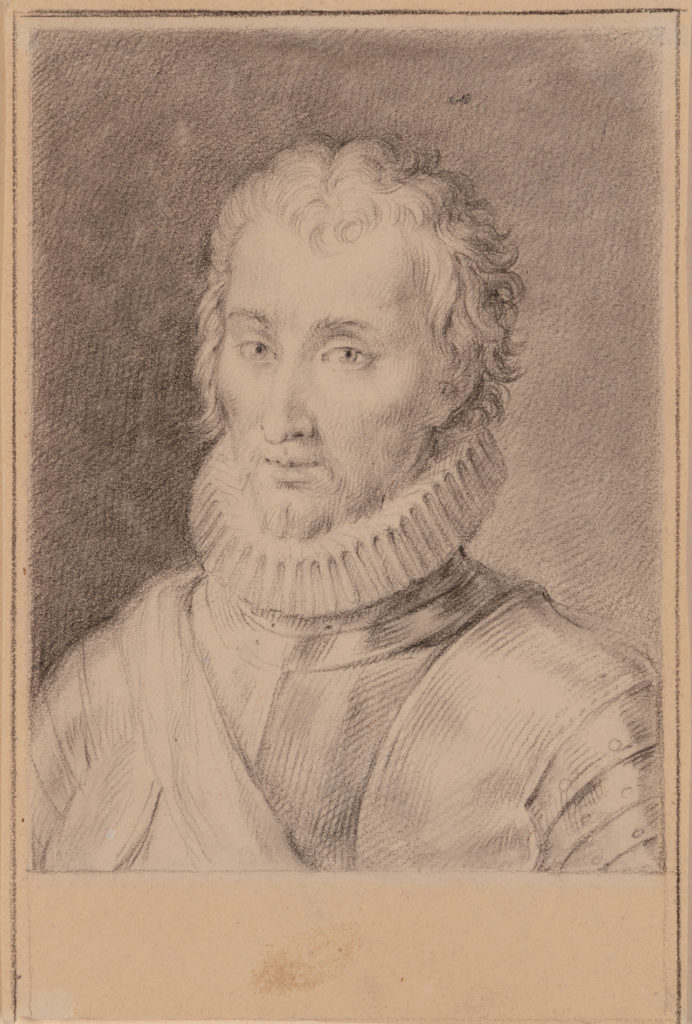
***
“A Baby Rolling Over” is not only the first work by Agustín Querol y Subirats to enter the Meadows Museum’s collection, it’s also the first example of nineteenth-century sculpture to be acquired by the Meadows.
Querol’s work is rarely of a scale that is practical for a public institution to own and exhibit; he is best known for monumental works such as the dramatic figures that top the Spanish Ministry of Agriculture in downtown Madrid and his “Allegory of Spain” on the façade of the Biblioteca Nacional de España.
In “A Baby Rolling Over,” Querol depicts a milestone event in the life of the young child, the moment when they learned how to roll over. It’s an intimate and sensitive work, created with the artist’s own hands as opposed to a workshop of assistants, as would be the case with his larger, commissioned works.
The sculpture was donated to the Meadows by Dr. Michael P. Mezzatesta, a noted art historian and the Mary D.B.T. and James H. Semans Director Emeritus of the Nasher Museum of Art at Duke University in honor of Dr. William B. Jordan, founding director of the Meadows Museum, who died in 2018. It is a fitting tribute to Jordan, whose own appreciation of Spanish terracotta sculpture was well known and evidenced by his 1999 donation of Luisa Roldán’s sculpture of Saint John the Baptist.

Learn more about the Meadows Museum at meadowsmuseumdallas.org.
> Sign up to receive Fine Art Today, our free weekly e-newsletter
> Click here to subscribe to Fine Art Connoisseur magazine, so you never miss an issue
> Join us for Realism Live, October 2020







